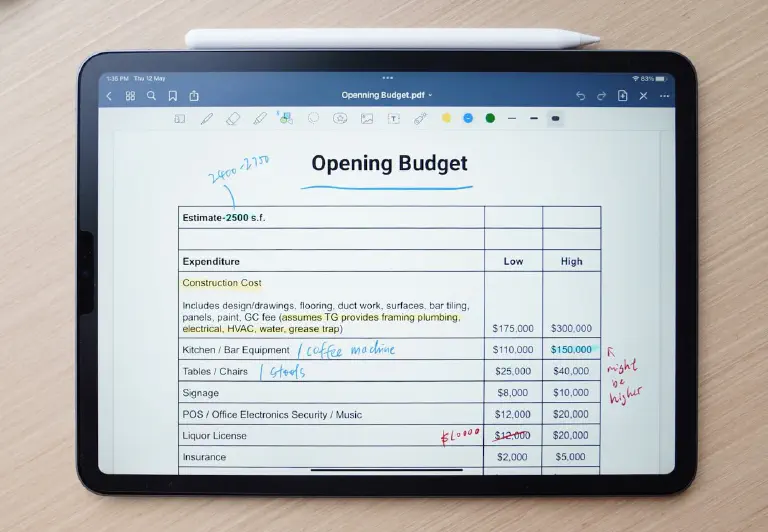Have you already drawn up your budget for next year? If not, it’s time: the sooner you know how much money you have available, the more precisely you can initiate measures to achieve your goals: Do you want to hire more employees or are you planning a major advertising campaign? No matter what you have in mind, this article will provide you with valuable tips for budget planning.
The following article deals with budget planning in companies and how best to approach it. For private households we recommend a budget book .
What is budgeting? #
Budgeting – also known as budget planning or budget allocation – is, as the name suggests, about the allocation of budgets and the planning of resources. By definition, budget planning is carried out for the future, usually for the following financial year. You can determine the budget for the entire company on the one hand and carry out detailed budgeting for specific departments or individual projects on the other. The resulting budget plan specifies where the available money in the company should go and what goals you want to achieve with it and over what period of time.

Advantages of forward-looking budget planning #
- Sensible budget allocation: Budget planning helps you to allocate money and resources sensibly to departments and projects and to use them specifically where they will bring the greatest possible benefit.
- Binding targets: With a binding budget plan, you can ensure that your managers formulate clear goals and take efficient measures to achieve them.
- Financial transparency: Budgeting provides clarity on what you are spending your money on. You can keep an eye on costs and targets, measure success and anticipate undesirable developments.
- Prioritized investments: The wish list in departments is often long. A fixed budget helps you to prioritize the crucial investments and avoid unnecessary expenditure.
Budgeting goes hand in hand with financial planning #
Operational budget planning is part of short-term financial planning , in which you estimate your future income and expenditure for the coming year. You use the data from the current and/or previous financial year to derive forecasts for future developments. In contrast to a financial plan , budgeting generally focuses on the expenditure side - regardless of where the money comes from.
Strategic budget planning for the next two to five years is also quite common. This helps you to make long-term business decisions that will drive your company forward and ensure its success, such as opening new locations. However, the further into the future the planning horizon is, the more difficult and uncertain it is to make an accurate forecast.

The budgeting process – how to plan your budget #
What is the best way to go about budgeting? Although there is no one-size-fits-all solution, you can follow a few steps and procedures for budget planning that have become established in many companies. However, the following points assume that an initial budget has already been drawn up or that it is possible to compare figures from previous years.
- Examine whether there are significant changes in your key financial figures (e.g. turnover, profit, costs) compared to the previous reference period.
- On this basis, forecast the future development of the available budget for the entire company.
- Now it’s time to allocate the budget: coordinate the sub-budgets with the individual departments using the following procedures.
What budgeting methods are there? #
There are three procedures or methods for budgeting that have proved particularly successful:
- Top-down: The management determines the overall budget as well as the budget distribution and the department/project managers then plan the measures they can implement with it.
- Bottom-up: Here, the department/project managers themselves determine what budget they need for their tasks and pass the budget planning on to the decision-makers. They add up the sub-budgets, compare them with the overall budget and determine what is approved.
- Counterflow procedure: Here you combine the top-down and bottom-up approach. The management sets targets, but does not go into detail regarding budgeting. The department/project managers then develop suitable measures and specify the planned expenditure. Finally, the management level must review the budgeting and bring it into line with the overall budget.

Possible problems with budget planning #
Like all business processes, budgeting can run more or less smoothly. You should be aware of a few stumbling blocks, even if it is impossible to prepare for all eventualities.
The following problems can occur:
- Depending on the complexity of the company structure (e.g. subsidiaries, locations, organizational levels), detailed budgeting can quickly become confusing.
- Budgeting usually requires a high expenditure of time and ties up personnel capacities that are not available for productive work.
- Today, economic developments are so fast-moving and difficult to predict that a budget planned well in advance rarely does justice to the actual circumstances.
- Strict budget targets restrict the departments’ room for maneuver when costs rise (e.g. in the event of unexpected price increases).
- It can also lead to the stagnation of the company if you orientate yourself too closely to the budgeting of previous years without rethinking and optimizing processes.
- Last but not least, rivalries between managers or entire departments can make efficient budget planning more difficult and encourage unnecessary spending.

7 tips for successful budgeting #
We have put together 7 tips to help you overcome these challenges:
1. Analyze data carefully #
Towards the end of the current financial year, evaluate your company’s performance based on the last budget and compare your forecast at that time with the actual figures. Do you still have money left over or have you already exceeded your budget? Are the targets you set still achievable or have they already been achieved?
2. Explain discrepancies #
If there are large deviations from the budget, you should find out whether there have been significant changes within or outside your company that you could not foresee in your forecast. As soon as you know the causes, you can initiate effective countermeasures or plan more budget in the future to achieve your goals.
3. Set realistic goals #
Do not increase the goals you want to achieve with your budget to immeasurable proportions. The budget planning of the individual departments should be realistic and match the expected success of the company.
4. Avoid inefficiency #
Money and resources should be used as efficiently (without waste) and effectively (to achieve objectives) as possible. However, it can be counterproductive if you simply cut the funds that a department has not used from next year’s budget. Instead of rewarding the economical use of resources, this encourages departments to use up the budget next year no matter whether measures make sense or not.
5. Recognize potential for conflict #
The size of the budget can quickly lead to competitive or status thinking (“whoever has more budget is more important”) among managers. Therefore, make sure to recognize conflicts regarding budgeting at an early stage and communicate clearly that all departments and projects contribute to the overall success.
6. Demand transparency #
Particularly in internal power struggles, results are often glossed over or exaggerated targets formulated in order to obtain a better budget. Be aware of this and look critically at what the funds are needed for and why. Ultimately, you should allocate your budget in such a way that your company achieves its business objectives.
7. Stay flexible #
Specific budgeting must remain adaptable, as it is partly based on assumptions for the future that cannot be predicted with certainty. If things develop differently than expected, you should react flexibly.
Budgeting in individual departments #
The budget planning for the entire company is made up of the sub-budgets of all departments. When allocating the budget, bear in mind that there will inevitably be imbalances: for example, the HR department usually bears by far the highest costs, but it also provides all other departments with human resources.
In order to make budgeting transparent, it is important to involve all departments in budget planning at an early stage. Important areas are personnel budget planning (recruiting, salaries, etc.), marketing budget planning and IT budget planning. These departments usually manage large budgets of their own and are indispensable for strategic budget planning.
Below we take a closer look at budget planning in IT and project management . If you are interested in personnel planning or a marketing plan , click on the linked articles for further information.
IT budget planning #
Functioning IT systems, automated processes and efficient data management are of central importance for all areas of the company. In addition, almost all employees need high-performance hardware (e.g. laptops, company cell phones) to be able to work productively. IT budget planning is therefore playing an increasingly important role. Basically, you can differentiate between these types of expenditure in IT budgeting:
-
Capital Expenditures (one-off investments): These are fixed assets such as hardware and infrastructure that you purchase yourself for a longer period of time, e.g. end devices, servers, network technology, monitors, headsets, etc.
-
Operating expenditures (ongoing operating costs): This includes the license fees for all software applications, operating systems and tools used (SaaS), but also rented infrastructure such as external servers and cloud services (IaaS) as well as internet and telephony costs. Added to this are services such as IT consulting, maintenance and support contracts. If necessary, you can also include the costs for your own IT staff in the IT budget planning and remove them from the personnel budget planning.
-
Furthermore, all projects that you want to complete with a concrete result within a financial year, e.g. the automation of a business process, the introduction of a new tool or a penetration test, must be taken into account in IT budgeting.
-
You should also include ongoing tasks such as IT training for new employees in your IT budgeting - because time is money.
Thanks to IT budgeting, it quickly becomes clear whether you can only finance the bare essentials or high-end solutions with your money and how quickly digitization and automation projects can be implemented. Include a buffer in the budget for unforeseen expenses (e.g. price increases, repair or replacement of broken devices).

Budget planning in project management #
A popular area of application for budgeting is project management. There, it provides you with an overview of what is possible in a project. Depending on the resources, you can decide, for example, whether you want to hire external service providers or whether you would rather manage the majority yourself.
Especially if customers, investors or other stakeholders are involved in a project, they will almost certainly demand transparent and realistic budgeting. In this case, a budget plan is essential and can be used to negotiate financial resources.
Budgeting should definitely take place before the project starts. It determines whether and to what extent a project is feasible. Budgeting reveals the objectives - both opportunities and risks become apparent. You should therefore start budgeting as early as possible.
In order to be able to realistically calculate cost estimates, it is helpful to review past projects. How well did the budget planning work in previous projects and what should you adjust this time? Creating a budget plan can be time-consuming, but it gives you the opportunity to evaluate old projects and make new ones even better.
An example of how you can implement budget planning #
Let’s take a look at an example of budget planning in practice. Let’s assume that a growing company with currently around 15 employees wants to plan its budget for 2024. The company offers services, which means that there are no production costs (e.g. for materials, machines, storage).
First, management analyzes all expenses and operating costs in 2023 and compares the figures with the 2023 budget plan. If the budget of a cost center has been exceeded, the responsible managers explain why the estimated budget was not sufficient. They then formulate their expectations and targets for the next year.
Based on these analyses and targets, the managers communicate how much money they want to spend in a bottom-up process. The management then sets a realistic overall budget for 2024 – and the targets to be achieved with it.
Create your budget plans with SeaTable #
Many people use Excel spreadsheets for their budget planning, but these only offer limited functions and display options. In SeaTable you can register free of charge and start directly with the template shown above. You can bundle and evaluate all cost centers, targets, budgets and expenses in such a central database.
Give your managers budget responsibility and use SeaTable as a collaboration tool to work on budgeting with several departments at the same time. This allows you to adjust the budget plan throughout the year, track the recording of expenses in real time and always have an overview of the current budget.
Try our free budget planning template and discover other exciting use cases you can implement with SeaTable.
TAGS: Finances Project Management
